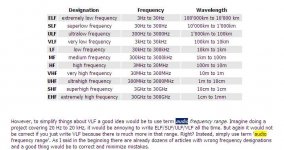thanks patrick. so a labsub and punisher subs are monopole too .
True.
But the horn cutoff is around 40-50hz on these boxes. So below that frequency, they're little different than a sealed box.
So you're getting this massive gain from 50hz to 200hz or so, but horn loading is doing nothing for the range from 10hz to approximately 50hz.
That's why sealed boxes are the hot ticket for ULF
True.
But the horn cutoff is around 40-50hz on these boxes. So below that frequency, they're little different than a sealed box.
So you're getting this massive gain from 50hz to 200hz or so, but horn loading is doing nothing for the range from 10hz to approximately 50hz.
That's why sealed boxes are the hot ticket for ULF
wow thanks i never new that i thought that horns were superior in everything .
o.k that raises up another question how comes labsub is rated at 30hz kf940 at 25hz ,pi labsub at 29hz and they all brag of a flat response from the lowest to around 200hz : is it true or marketing hype?
A monopole is any speaker where the rear wave is enclosed. (Sealed box, front loaded horn, single reflex bandpass.)
Of those three types, a plain ol' sealed box has the lowest F3 for a given box size. So if your subwoofer is going in a room or in a car, a plain ol' sealed box is tough to beat.
Yes, this is a complete 180 from how I felt up until 2011 or so, so you can find threads on here and Diyma where I argued the opposite
But John K and Geddes convinced me otherwise.
Not sure I follow you here. Vented boxes (BR) usually have a lower f3, vs. sealed. Along with a very wide bandwidth, reasonable efficiency, and low group delay in the midbass.
Clearly, horns are best for maximizing efficiency at the expense of bandwidth and group delay.
Each type of box has it's advantages and disadvantages.
Last edited:
Hi Patrick Bateman,
Posts #18/20: "...But John K and Geddes convinced me otherwise."
Could you, please, provide references/quotations/links to support that statement, and what frequency range are you talking about when you use the term ULF?
Regards,
Here's some comments from Geddes:
http://www.diyaudio.com/forums/subwoofers/114340-tapped-horn-dummies-3.html
Note that I'm arguing against him in that thread, but I've come around to his way of thinking after reflecting on what he's written, and also John K
Basically, I believe that tapped horns, vented boxes and dipoles are better suited to frequencies above the Schroeder Frequency
Hi Patrick Bateman,
Posts #18/20: "...But John K and Geddes convinced me otherwise."
Could you, please, provide references/quotations/links to support that statement, and what frequency range are you talking about when you use the term ULF?
Regards,
I forgot to define "ULF". I'd argue it's anything below th Schroeder frequency
John K and Linkwitzlab reference this in their writings:
Room Acoustics
Believe me this isn't a knock against THs. I <3 'em. But sealed boxes give you more output per square foot in a room or in a car below the Schroeder frequency
One nice thing about FLHs and band pass boxes is that they basically operate like a sealed box below their cutoff, so they potentially offer wider bandwidth than the sims would tell u. For instance, in a car you can tune a band pass to cover one octave from 80hz to 160hz and basically get the three octaves from 10hz to 80hz "for free", because room gain offsets the gentle roll off of a monopole. The same cannot be said for TH or vented.
Hi Patrick Bateman,
Thank you for the link in Post #28.
It appears to me, that Mr. Linkwitz advocates dipole type (sub)woofers in the referenced writing, and he indicates the Schroeder frequency-for rooms between 1400 and 4000 ft^3-to be between 100 and 200 Hz depending on surface absorption, which would be well above subwoofer territory. As to monopoles he has a write-up on his Thor sealed box woofer, but here he is talking about the range below 40 Hz, and this is not just a box, but a system requiring equalization for optimum results.
Post #27:
I have read through "Tapped Horn for Dummies" more than once, and while there is some discourse between Mr. Geddes and Mr. Danley, I just cannot find anything to support your conclusion that, Post #27: "...tapped horns, vented boxes and dipoles are better suited to frequencies above the Schroeder Frequency".
I'm not sufficiently familiar with John K's writings to have an opinion about his subwoofer preferences.
As to ULF here is a reference for the proper designations of frequency ranges: Frequency bands
I'll attach a quick screen print from this article for reference.
Regards,
Thank you for the link in Post #28.
It appears to me, that Mr. Linkwitz advocates dipole type (sub)woofers in the referenced writing, and he indicates the Schroeder frequency-for rooms between 1400 and 4000 ft^3-to be between 100 and 200 Hz depending on surface absorption, which would be well above subwoofer territory. As to monopoles he has a write-up on his Thor sealed box woofer, but here he is talking about the range below 40 Hz, and this is not just a box, but a system requiring equalization for optimum results.
Post #27:
I have read through "Tapped Horn for Dummies" more than once, and while there is some discourse between Mr. Geddes and Mr. Danley, I just cannot find anything to support your conclusion that, Post #27: "...tapped horns, vented boxes and dipoles are better suited to frequencies above the Schroeder Frequency".
I'm not sufficiently familiar with John K's writings to have an opinion about his subwoofer preferences.
As to ULF here is a reference for the proper designations of frequency ranges: Frequency bands
I'll attach a quick screen print from this article for reference.
Regards,
Attachments
Hi,
Just to add to Post #30: this seems to be John K's website Music and Design, and I cannot find anything in there to support using him as a reference for the statements in e.g.: Posts #27/28.
Regards,
Just to add to Post #30: this seems to be John K's website Music and Design, and I cannot find anything in there to support using him as a reference for the statements in e.g.: Posts #27/28.
Regards,
I don't recall the 3x6" design
Hi Art,
I found the quote I was thinking of (Taken from this thread):
If I were to start from scratch (I have had the HF drivers since 1992, and the 8" for a decade or so) I'd be inclined to use four 6.5" and one (or two) 1" driver per cabinet, more height per $$ and more extended HF.
Art
<snip>
Post #27:
I have read through "Tapped Horn for Dummies" more than once, and while there is some discourse between Mr. Geddes and Mr. Danley, I just cannot find anything to support your conclusion that, Post #27: "...tapped horns, vented boxes and dipoles are better suited to frequencies above the Schroeder Frequency".
I'm not sufficiently familiar with John K's writings to have an opinion about his subwoofer preferences.
As to ULF here is a reference for the proper designations of frequency ranges: Frequency bands
I'll attach a quick screen print from this article for reference.
Regards,
Here's one of the quotes from Geddes:
"This just doesn't sit right with me. Dipoles have a very low radiation efficiency so it seems to me that they could never equal a monpole. I've always thought that the "both sides of the diaphragm" argument was flawed because it ignores that fact that these two sides are out of phase and that getting them in-phase to radiate efficiently is no small feat. The dual bandpass system cannot achieve any greater output that a single, it can just extend this output a little lower - just like a ported enclosure, but it does so at the cost of a dipole roll-off rather than a monopole."
Also, if I'm not mistaken, Geddes sells monopoles (sealed or single reflex band pass) exclusively. No vented boxes. I have a set of Summas, and he switched frm vented to sealed around 2005 iirc.
I believe that for a given box size, you cannot beat monopole below the Schroeder Frequency.
Can you get a lower F3 with a dipole*? YES - but the box is going to be larger. If you scaled the box size down, so it was equal to a sealed box, the f3 would rise, and then we're back to square one.
(when I say "dipole" I mean a box type where the rear wave is not enclosed. Vented, TH, BLH, dual reflex band pass and dipole)
Tinitus,I dont remember seeing any TH that was much good above 100hz
but I wouldnt mind to be wrong
so if there is one....?
Perhaps you missed the one in post #2 that is good to above 300 Hz?
Art
Here's one of the quotes from Geddes:
"This just doesn't sit right with me. Dipoles have a very low radiation efficiency so it seems to me that they could never equal a monpole. I've always thought that the "both sides of the diaphragm" argument was flawed because it ignores that fact that these two sides are out of phase and that getting them in-phase to radiate efficiently is no small feat. The dual bandpass system cannot achieve any greater output that a single, it can just extend this output a little lower - just like a ported enclosure, but it does so at the cost of a dipole roll-off rather than a monopole."
Also, if I'm not mistaken, Geddes sells monopoles (sealed or single reflex band pass) exclusively. No vented boxes. I have a set of Summas, and he switched frm vented to sealed around 2005 iirc.
I believe that for a given box size, you cannot beat monopole below the Schroeder Frequency.
Can you get a lower F3 with a dipole*? YES - but the box is going to be larger. If you scaled the box size down, so it was equal to a sealed box, the f3 would rise, and then we're back to square one.
(when I say "dipole" I mean a box type where the rear wave is not enclosed. Vented, TH, BLH, dual reflex band pass and dipole)
So pat, you're arguing that just for a given box size, not any box size, that a sealed box can't be beat below Fs? But not if that box were much larger...
Hi there,
Tapped Horns are more efficient as sealed enclosures at cost of volume. When you compare a Tapped Horn with multiple sealed enclosures that have a combined volume that is equal, the Tapped Horn is still more efficient...but... above a certain frequency. You cannot pinpoint it to hard frequency numbers because several factors are involved. One of these factors Danley once described as, 'capacitance of air', but he didn't explain it as far as I know.
Maybe what he meant is that the air inside an enclosure has certain stiffness (resistance). When frequency drops, this stiffness increases (capacitance). At the surface of the enclosure walls the speed of the air drops dramatically (boundary conditions), to almost zero. This effect increases the stiffness even further (capacitance). What that means is that the stiffness in the tapped horn (or pipe if you prefer) increases more than in small closed enclosures. But again, this is frequency depending which gives it a capacitance value. More simplistic, the air inside the tapped horn starts to behave like a high pass filter. The result is that the multiple sealed enclosures of equal total volume do become more efficient at some point in frequency.
You cannot model this with HornResp, Akabak or MathCad. If you want to model this effect you have to dive in the world of fluid dynamics which is only used by certain pro brands. Well, Martin (Xoc1) also seems to be interested in that field as he showed with his Xoc1-TH18. I don’t know if Danley Labs uses this type of modelling but so far I haven’t seen Danley mentioning it.
Tapped Horns are more efficient as sealed enclosures at cost of volume. When you compare a Tapped Horn with multiple sealed enclosures that have a combined volume that is equal, the Tapped Horn is still more efficient...but... above a certain frequency. You cannot pinpoint it to hard frequency numbers because several factors are involved. One of these factors Danley once described as, 'capacitance of air', but he didn't explain it as far as I know.
Maybe what he meant is that the air inside an enclosure has certain stiffness (resistance). When frequency drops, this stiffness increases (capacitance). At the surface of the enclosure walls the speed of the air drops dramatically (boundary conditions), to almost zero. This effect increases the stiffness even further (capacitance). What that means is that the stiffness in the tapped horn (or pipe if you prefer) increases more than in small closed enclosures. But again, this is frequency depending which gives it a capacitance value. More simplistic, the air inside the tapped horn starts to behave like a high pass filter. The result is that the multiple sealed enclosures of equal total volume do become more efficient at some point in frequency.
You cannot model this with HornResp, Akabak or MathCad. If you want to model this effect you have to dive in the world of fluid dynamics which is only used by certain pro brands. Well, Martin (Xoc1) also seems to be interested in that field as he showed with his Xoc1-TH18. I don’t know if Danley Labs uses this type of modelling but so far I haven’t seen Danley mentioning it.
Last edited:
Patrick Bateman, the point of all dipoles except the linkwitz type is to delay one sides radiation so that it adds to the other sides radiation in a certain frequency range. in that range, the dipole is superior to a monopole, out of that range it is unusable. geddes referred to the out of the usable frequency range problems of the dipole.
now you could say "but hoffmans law"...
well, hoffmans law, while only being a rule of thump, applies to total radiated energy over all frequencies. if you have a box type that by design limits the usable frequency range, you can "stuff" more energy into it from the range you dont use. for example like you would do with a bassreflex that has a bump in its frequency but then a rolloff thats steeper than a sealed box. you shift usable energy around, making it more efficient in the passband and less in the outer regions.
now you could say "but hoffmans law"...
well, hoffmans law, while only being a rule of thump, applies to total radiated energy over all frequencies. if you have a box type that by design limits the usable frequency range, you can "stuff" more energy into it from the range you dont use. for example like you would do with a bassreflex that has a bump in its frequency but then a rolloff thats steeper than a sealed box. you shift usable energy around, making it more efficient in the passband and less in the outer regions.
Hi Patrick Bateman,
Post #33: "...(when I say "dipole" I mean a box type where the rear wave is not enclosed. Vented, TH, BLH, dual reflex band pass and dipole)"
I don't think that your use of the term dipole is the universally accepted one, at least it's not the one I'm used to, e.g.: Dipole speaker - Wikipedia, the free encyclopedia. So that explains part of my confusion. Anyway, I wonder if Mr. Geddes uses dipole with your definition in the example you are picking out of your http://www.diyaudio.com/forums/subwoofers/114340-tapped-horn-dummies-3.html thread?
There is a great deal of "interesting stuff" in that thread, to me the meat of the discussion starts with Post #104 http://www.diyaudio.com/forums/subwoofers/114340-tapped-horn-dummies-11.html. Hidden somewhere in there is a really good discussion of the workings of not just tapped horns, and I'm going to enjoy reading through it again.
Regards,
Post #33: "...(when I say "dipole" I mean a box type where the rear wave is not enclosed. Vented, TH, BLH, dual reflex band pass and dipole)"
I don't think that your use of the term dipole is the universally accepted one, at least it's not the one I'm used to, e.g.: Dipole speaker - Wikipedia, the free encyclopedia. So that explains part of my confusion. Anyway, I wonder if Mr. Geddes uses dipole with your definition in the example you are picking out of your http://www.diyaudio.com/forums/subwoofers/114340-tapped-horn-dummies-3.html thread?
There is a great deal of "interesting stuff" in that thread, to me the meat of the discussion starts with Post #104 http://www.diyaudio.com/forums/subwoofers/114340-tapped-horn-dummies-11.html. Hidden somewhere in there is a really good discussion of the workings of not just tapped horns, and I'm going to enjoy reading through it again.
Regards,
When I get a chance, I'll post some data to back up my argument that a monopole is superior below the Schraeder Frequency.
In the meantime, here are some pics and measurements of a push-pull midbass tapped horn that I built a few years ago.
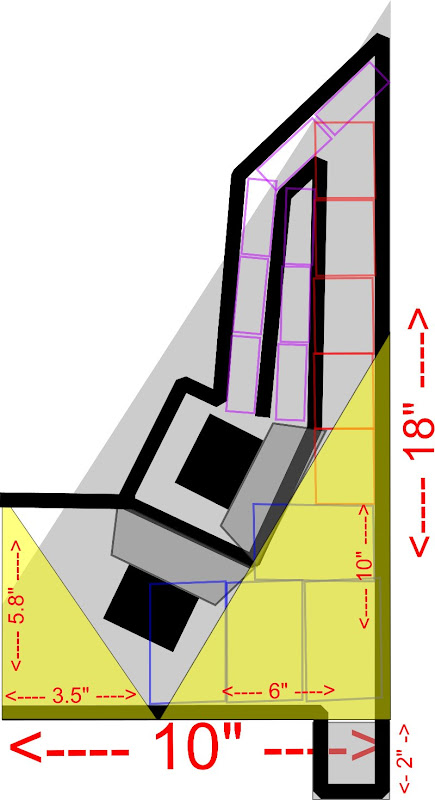
Here's the plans. I did these in Xara X. It's free for Linux.
The shape is odd because it's designed to go under the dash of a car.
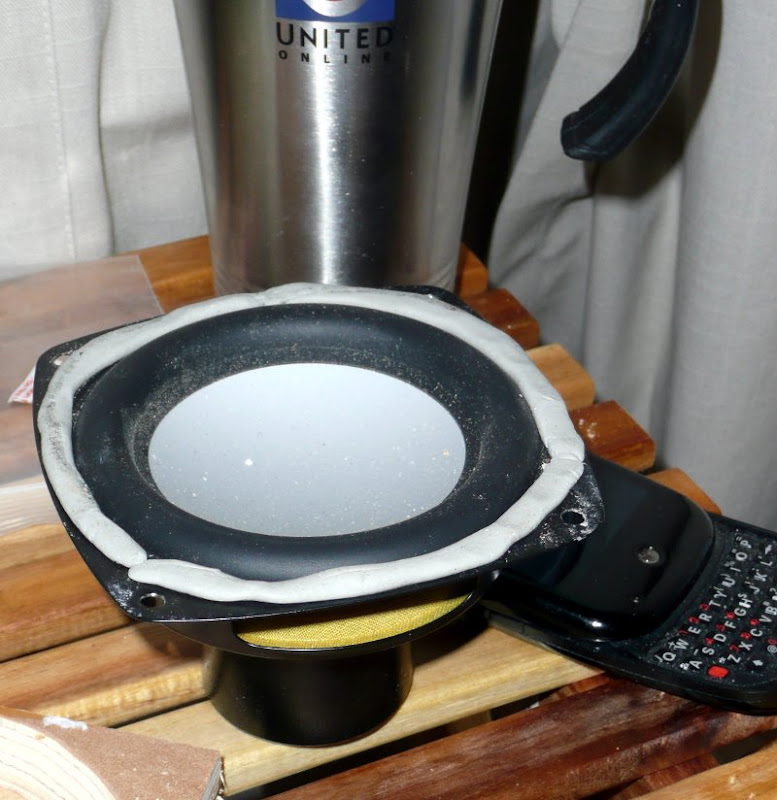

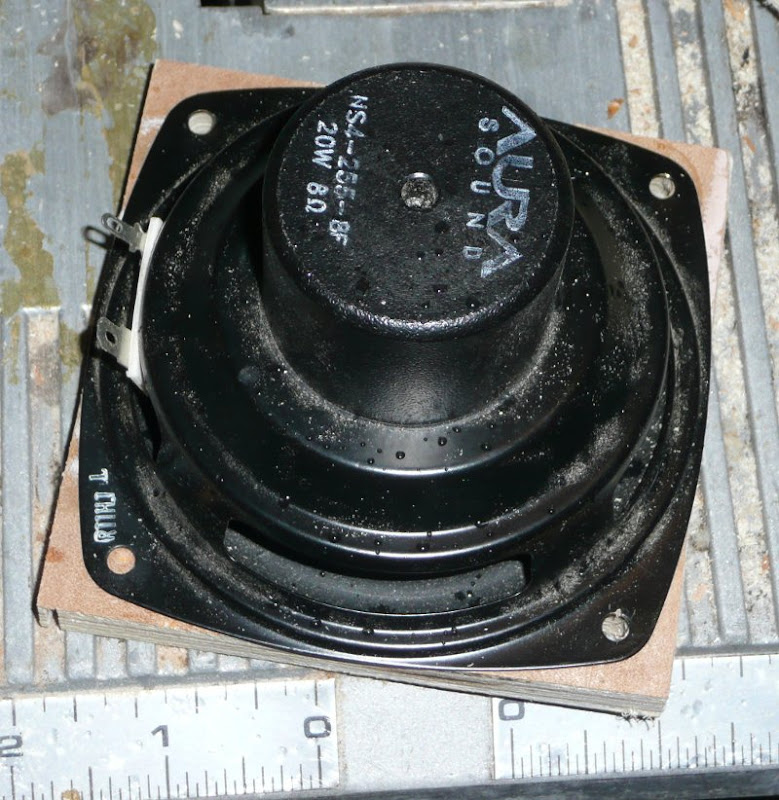
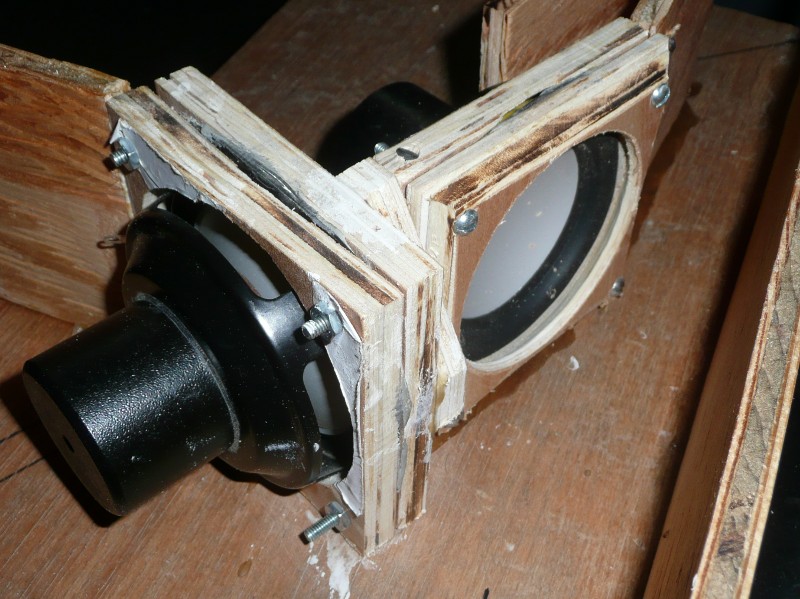

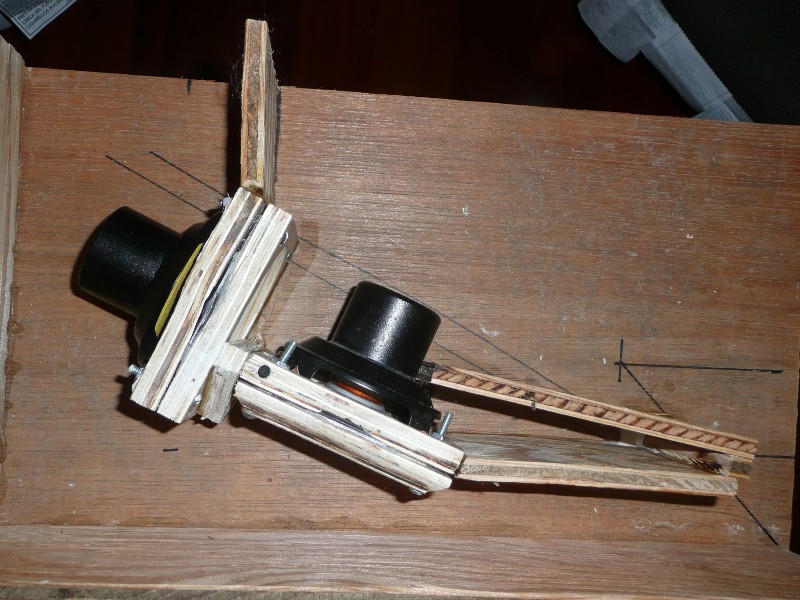
Getting the drivers really close together was a bit tricky, as you can see. They're wired in push-pull because it reduces second harmonic distortion.
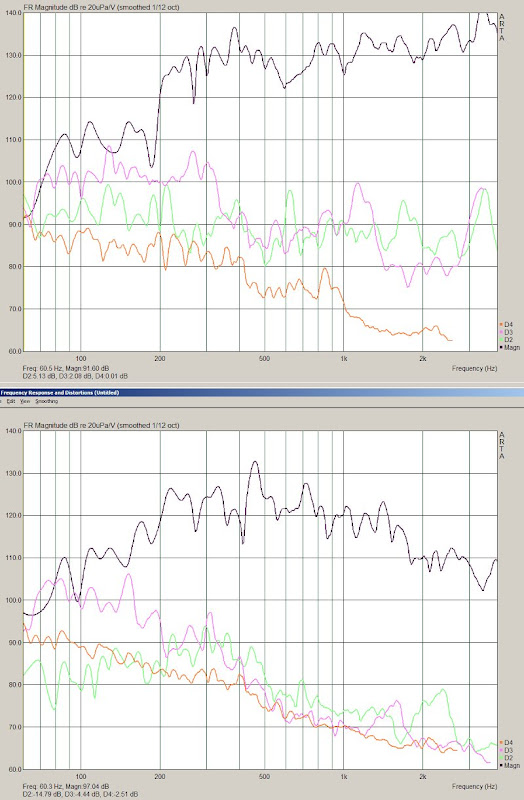
I didn't label this measurement on my hard drive. But if memory serves, I'd built a tapped horn and a front-loaded horn, both using the Aurasound NS4. The measurement with more extended high frequency response is the tapped horn. The measurement with lower levels of second harmonic distortion below 200hz is the front loaded horn.
In the meantime, here are some pics and measurements of a push-pull midbass tapped horn that I built a few years ago.

Here's the plans. I did these in Xara X. It's free for Linux.
The shape is odd because it's designed to go under the dash of a car.






Getting the drivers really close together was a bit tricky, as you can see. They're wired in push-pull because it reduces second harmonic distortion.

I didn't label this measurement on my hard drive. But if memory serves, I'd built a tapped horn and a front-loaded horn, both using the Aurasound NS4. The measurement with more extended high frequency response is the tapped horn. The measurement with lower levels of second harmonic distortion below 200hz is the front loaded horn.
Forgot to mention - the SPL levels in the distortion measurement from my last post are not calibrated. Basically I used the same voltage for the front-loaded-horn and the tapped horn, but I did not measure what that voltage was. It was around 1 watt. The distortion levels have been raised by 10 or 20dB, to make it easier to see where they are. (I did these measurements two or three years ago, and all my notes were on a hard drive that crashed.)
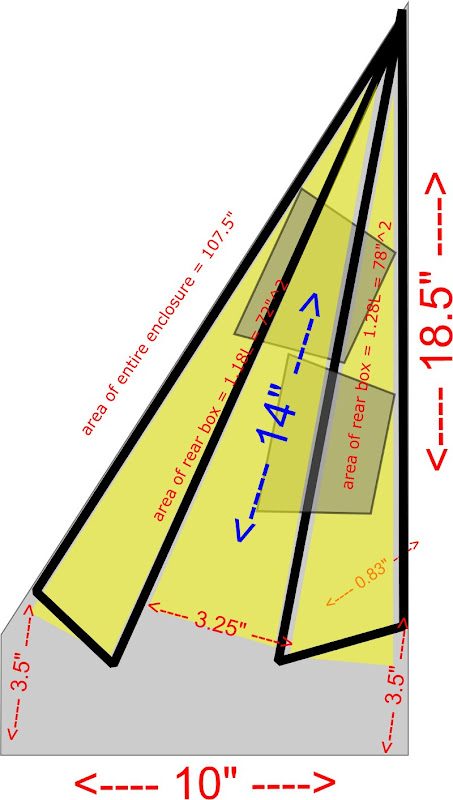
Here are the plans for the FLH, using the same drivers. It's a strange forn holding scheme, because I had to stuff it under the dash of a car, while maintaining push-pull radiation.

The tapped horn definitely has a 'cleaner' fold than the FLH
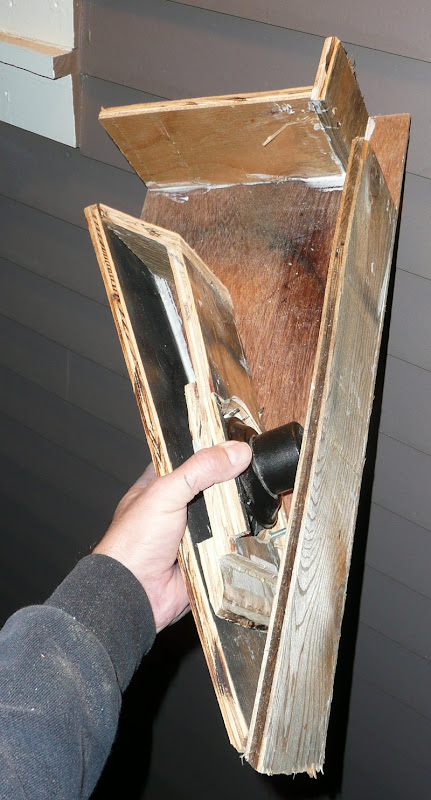
Here's a pic of the partially finished FLH. Again, foot print of the TH and the FLH midbass horn are the same, so I could make an 'apples to apples' comparison

Here are the plans for the FLH, using the same drivers. It's a strange forn holding scheme, because I had to stuff it under the dash of a car, while maintaining push-pull radiation.

The tapped horn definitely has a 'cleaner' fold than the FLH

Here's a pic of the partially finished FLH. Again, foot print of the TH and the FLH midbass horn are the same, so I could make an 'apples to apples' comparison
Last edited:
- Status
- This old topic is closed. If you want to reopen this topic, contact a moderator using the "Report Post" button.
- Home
- Loudspeakers
- Subwoofers
- Midbass tapped horns?
